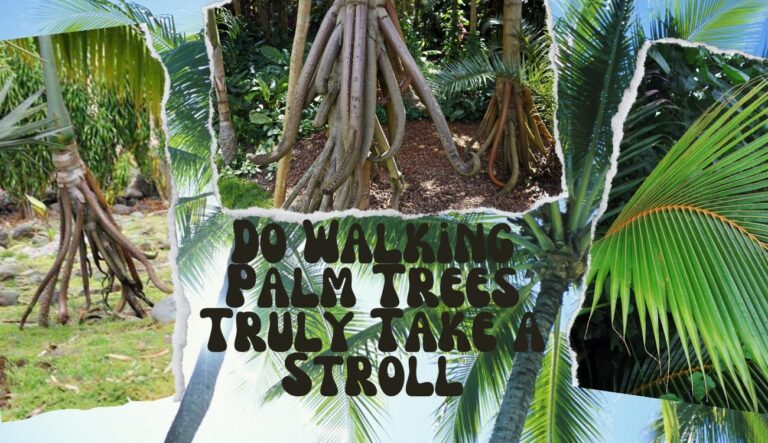Have you ever heard of a tree that walks? Yes, you read that right. A tree that walks! This might sound like something straight out of a fantasy novel, but it’s a question that has intrigued botanists, nature enthusiasts, and curious minds alike for years.
The Walking Palm Tree, as it’s commonly known, has been the subject of many debates and discussions. Does it really walk, or is it just a myth? Let’s embark on a fascinating journey to unravel this mystery.
Located in the rainforests of Central and South America, they are known for their peculiar root system that gives the illusion of the tree moving or “walking.” This has led to numerous stories and folklore surrounding these trees, with some even claiming to have witnessed them move. But is there any truth to these claims? Or is it just a figment of our imagination?
The Enigmatic Reputation: Myth or Reality
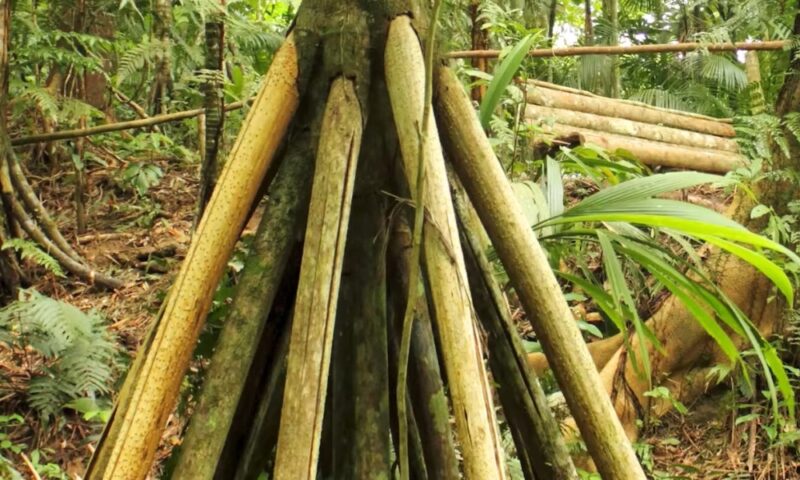
The Walking Palm Tree has always been shrouded in mystery and intrigue. Some indigenous communities believe that these trees can move to a new location if they’re not happy where they are. Others claim that these trees can slowly move towards sunlight, a phenomenon known as phototropism.
Scientifically speaking, trees cannot uproot themselves and move to a new location. They are stationary organisms that grow in one place. However, the Walking Palm Tree has a unique root system that gives the illusion of movement.
Its stilt-like roots grow out from the trunk above the ground level, and new roots can grow on one side of the tree, while the older roots on the opposite side die off. This can give the appearance of the tree moving or “walking.”
While the idea of a walking tree is fascinating, it’s important to separate fact from fiction. The Walking Palm Tree doesn’t actually walk in the literal sense. But this doesn’t make these trees any less fascinating. In fact, their unique adaptations and survival strategies make them one of the most interesting species in the plant kingdom.
Cultural Beliefs and Folklore Associated with These Peculiar Trees
The Walking Palm Trees hold a special place in the cultural beliefs and folklore of the indigenous communities in Central and South America. These trees are often seen as symbols of resilience and adaptability, embodying the spirit of the rainforest. They are also associated with various myths and legends, adding to their mystique and allure.
One popular belief is that these trees have spirits and can move to a new location if they’re unhappy. This belief stems from the tree’s unique root system and the illusion of movement it creates. Some indigenous communities also believe that these trees can bring good luck and ward off evil spirits. They are often included in sacred rituals and ceremonies, further highlighting their cultural significance.
Despite the scientific explanation behind the “walking” phenomenon, these cultural beliefs and folklore continue to thrive. They add a layer of mystique to these trees and enhance the allure of these botanical marvels. They serve as a reminder of the rich cultural heritage and the deep connection between humans and nature.
The Scientific Name: Exploring the Genus Socratea and Its Unique Adaptations
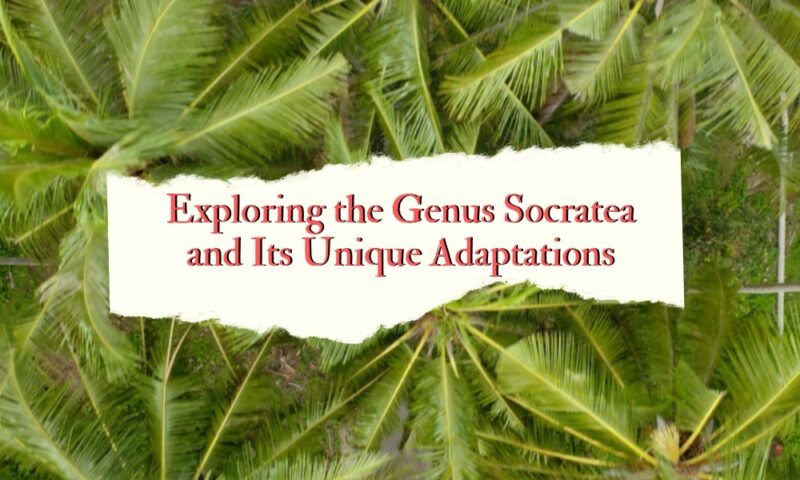
The Walking Palm Tree belongs to the genus Socratea, specifically the species Socratea exorrhiza. This Latin name may not roll off the tongue as easily as “Walking Palm,” but it holds the key to understanding the unique adaptations of these trees. The term “exorrhiza” refers to the tree’s distinctive root system, which grows outside the soil, a feature that sets it apart from most other trees.
The roots of Socratea exorrhiza are stilt-like, growing out from the trunk above the ground level. This unique adaptation allows the tree to anchor itself in the unstable and nutrient-poor soils of the rainforest. It also enables the tree to access nutrients from a larger area, as the roots can spread out in all directions. This root system is what gives the tree its “walking” appearance, as new roots can grow on one side while the older roots on the opposite side die off.
While the “walking” phenomenon is more of an illusion, the unique adaptations of Socratea exorrhiza are very real. They are a testament to the tree’s resilience and adaptability, allowing it to thrive in the challenging conditions of the rainforest. These adaptations also play a crucial role in the tree’s survival strategy, as we will explore in the following sections.
The Illusion of Movement: Shedding Light on the Illusion

The idea of a walking tree is undoubtedly fascinating, but it’s important to understand that it’s more of an illusion than actual movement. The Walking Palm Tree doesn’t uproot itself and move to a new location. Instead, it’s the tree’s unique growth pattern and root system that give the illusion of movement.
The roots of the Walking Palm Tree are stilt-like, growing out from the trunk above the ground level. As the tree grows, new roots can develop on one side, while the older roots on the opposite side die off. This can give the appearance of the tree moving or “walking” over time. However, this process is slow and gradual, taking place over several years.
While the Walking Palm Tree doesn’t walk in the literal sense, the illusion of movement is a fascinating aspect of its biology. It’s a testament to the tree’s adaptability and resilience, allowing it to survive and thrive in the challenging conditions of the rainforest.
Geotropism and Phototropism in Their Growth Patterns
Geotropism and phototropism are two key factors that influence the growth patterns of the Walking Palm Tree. Geotropism refers to the growth of plants in response to gravity, while phototropism refers to the growth in response to light. These two factors play a crucial role in the tree’s unique “walking” phenomenon.
The roots of the Walking Palm Tree grow downwards due to geotropism, helping the tree anchor itself in the unstable soils of the rainforest. However, the roots also grow outwards in all directions, allowing the tree to access nutrients from a larger area. This lateral growth of the roots is what gives the tree its “walking” appearance.
Phototropism, on the other hand, influences the growth of the tree’s canopy. The tree bends towards the light, maximizing its exposure to sunlight and optimizing photosynthesis. This bending towards the light can also contribute to the illusion of the tree moving or “walking.”
Understanding the role of geotropism and phototropism in the growth patterns of the Walking Palm Tree helps us appreciate the complexity of these botanical marvels. It’s a testament to the intricate balance of nature and the remarkable ways in which plants adapt to their environment.
Rooted in Survival: The Purpose Behind the Curved Roots

The Walking Palm Tree’s unique root system is not just for show. It plays a crucial role in the tree’s survival strategy. The curved, stilt-like roots allow the tree to anchor itself in the unstable and nutrient-poor soils of the rainforest. They also enable the tree to access nutrients from a larger area, as the roots can spread out in all directions.
The roots of the Walking Palm Tree are also known to propagate or grow outwards, a phenomenon known as lateral propagation. This allows the tree to access nutrients from a larger area and helps it survive in the nutrient-poor soils of the rainforest. The roots can also grow towards areas with better light and nutrient availability, further enhancing the tree’s survival chances.
The curved roots of the Walking Palm Tree are a testament to the tree’s adaptability and resilience. They highlight the remarkable ways in which plants adapt to their environment and the intricate balance of nature. They also serve as a reminder of the importance of preserving these unique ecosystems and the diverse life forms they support.
Going Against Gravity: the Lateral Propagation
One of the most fascinating aspects of the Walking Palm Tree is its ability to go against gravity. While most trees grow upwards towards the light, the Walking Palm Tree also grows outwards in all directions, a phenomenon known as lateral propagation. This unique growth pattern is a key factor behind the tree’s “walking” appearance.
The roots of the Walking Palm Tree grow out from the trunk above the ground level, allowing the tree to access nutrients from a larger area. As the tree grows, new roots can develop on one side, while the older roots on the opposite side die off. This lateral growth of the roots can give the appearance of the tree moving or “walking” over time.
While the Walking Palm Tree doesn’t actually uproot and walk, its unique growth pattern and root system are a testament to its adaptability and resilience. They allow the tree to thrive in the challenging conditions of the rainforest and highlight the remarkable ways in which plants adapt to their environment.
Embracing the Sun: Phototropism and Sunlight Optimization
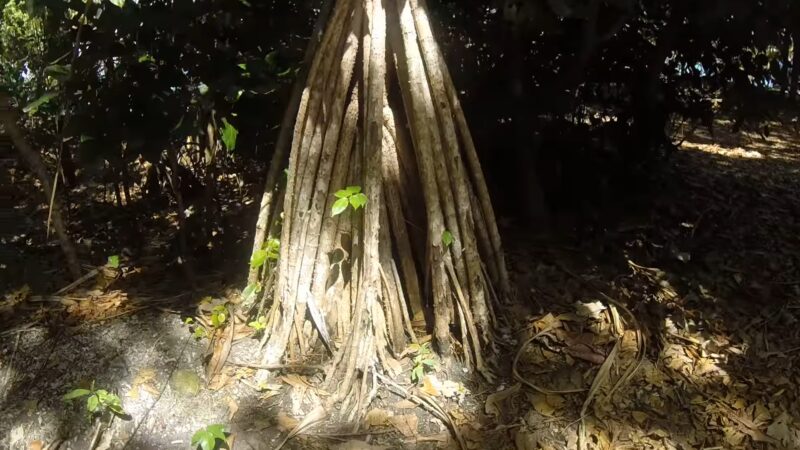
The Walking Palm Tree is not just a walker; it’s also a sun chaser. The tree exhibits a phenomenon known as phototropism, where it grows towards the light. This allows the tree to maximize its exposure to sunlight and optimize photosynthesis, the process by which plants convert sunlight into energy.
The canopy of the Walking Palm Tree is known to bend towards the light, maximizing its exposure to sunlight. This bending towards the light can also contribute to the illusion of the tree moving or “walking.” However, it’s not just the canopy that responds to light. The roots also grow towards areas with better light availability, further enhancing the tree’s survival chances.
Phototropism is a common phenomenon in plants, but it’s particularly pronounced in the Walking Palm Tree. It’s a testament to the tree’s adaptability and its ability to optimize its growth for survival. It also serves as a reminder of the intricate balance of nature and the remarkable ways in which plants adapt to their environment.
Exploring the Habitat: Where Do Walking Palm Trees Thrive?
Walking Palm Trees are native to the rainforests of Central and South America. They thrive in the humid, tropical conditions of these rainforests, where they are often found in swampy areas or along riverbanks. The unstable and nutrient-poor soils of these habitats might seem challenging, but the Walking Palm Trees have adapted to thrive in these conditions.
The unique root system of the Walking Palm Trees allows them to anchor themselves in these soils and access nutrients from a larger area. The humid, tropical climate of these rainforests also provides the ideal conditions for these trees to thrive.
Despite their adaptability, Walking Palm Trees face several threats in their natural habitats. Deforestation and illegal logging are major threats, leading to habitat loss and population decline. Climate change also poses a significant threat, as changes in temperature and rainfall patterns can impact the growth and survival of these trees.
The conservation status of Walking Palm Trees is currently not well-documented, highlighting the need for more research and conservation efforts. These trees play a crucial role in the rainforest ecosystem, and their loss could have far-reaching impacts on biodiversity and the health of the rainforest.
Symbiotic Relationships: Interactions with Wildlife and Plants
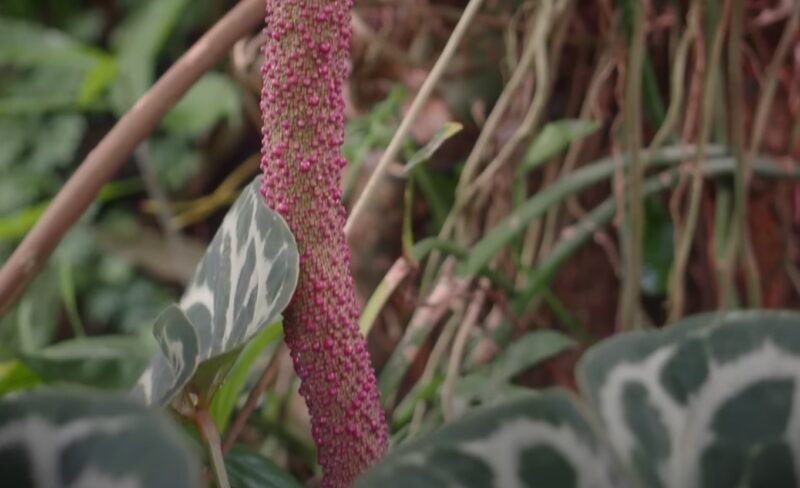
Walking Palm Trees are not just fascinating in their own right; they also play a crucial role in the rainforest ecosystem. They form symbiotic relationships with various species of wildlife and plants, contributing to the rich biodiversity of the rainforest.
Birds, insects, and other small animals often find shelter in the dense canopy of the Walking Palm Trees. The trees also provide food for various species, with their fruits and seeds being a valuable food source. Some species of ants are known to live in the hollow roots of these trees, protecting the tree from harmful insects in return for shelter.
The Walking Palm Trees also interact with other plants in the rainforest. Their tall, slender trunks provide support for climbing plants and vines, while their roots help stabilize the soil and prevent erosion. These interactions highlight the interconnectedness of the rainforest ecosystem and the crucial role these trees play in maintaining its health and diversity.
Human Impact: Conservation Efforts and Threats to Walking Palm Trees
Despite their adaptability and resilience, Walking Palm Trees face several threats in their natural habitats. Deforestation and illegal logging are major threats, leading to habitat loss and population decline. These activities not only threaten the survival of the Walking Palm Trees but also disrupt the delicate balance of the rainforest ecosystem.
Climate change also poses a significant threat to Walking Palm Trees. Changes in temperature and rainfall patterns can impact the growth and survival of these trees. Rising temperatures can lead to increased evaporation, reducing the availability of water for these trees. Changes in rainfall patterns can also affect the nutrient availability in the soil, impacting the tree’s growth and survival.
Conservation efforts are crucial to protect Walking Palm Trees and their habitats. These efforts include protecting and restoring rainforest habitats, enforcing laws against illegal logging, and raising awareness about the importance of these trees. It’s also important to conduct more research on these trees, as their conservation status is currently not well-documented.
Cultural Significance and Ethnobotanical Uses
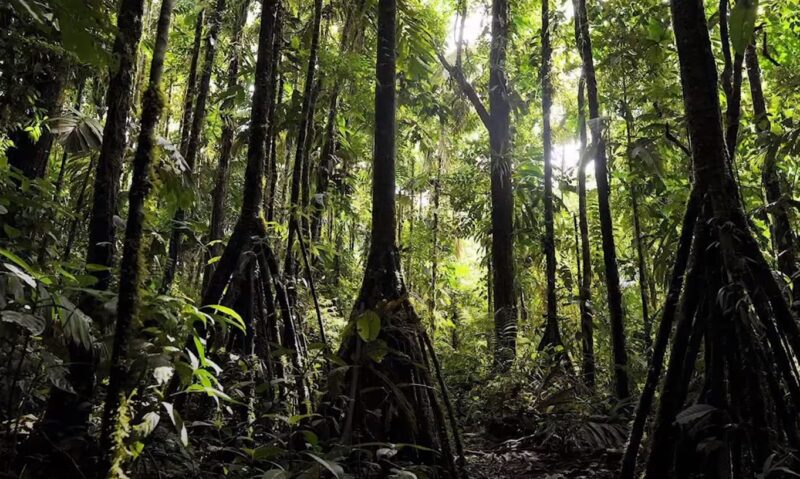
Walking Palm Trees hold significant cultural and ethnobotanical value, particularly among the indigenous communities in Central and South America. These trees are often used in traditional medicine, with various parts of the tree being used to treat a range of ailments. The roots, for example, are used to treat liver problems, while the leaves are used to treat wounds and injuries.
The wood of the Walking Palm Trees is also highly valued for its strength and durability. It’s often used in construction, making everything from houses to furniture. The leaves are used for thatching roofs, while the fibers are used to make ropes and baskets.
Despite their cultural and ethnobotanical value, Walking Palm Trees are often overlooked in conservation efforts. This highlights the need to not only protect these trees but also recognize and respect the traditional knowledge and practices associated with them.
Beyond the Myth: the Majesty of Walking Palm Trees
Walking Palm Trees are more than just the subject of a fascinating myth. They are a testament to the adaptability and resilience of nature, showcasing the remarkable ways in which plants adapt to their environment. They are also a crucial part of the rainforest ecosystem, forming symbiotic relationships with various species of wildlife and plants.
While the “walking” phenomenon is more of an illusion, it doesn’t make these trees any less fascinating. It serves as a reminder of the intricate balance of nature and the beauty and diversity of the plant kingdom. It also underscores the importance of preserving these unique ecosystems and the diverse life forms they support.
FAQs:
How have human activities impacted Walking Palm Tree populations?
Human activities such as deforestation and illegal logging have led to habitat loss and population decline for these plants.
How have Walking Palm Trees been integrated into traditional medicine practices?
Various parts of these plants have been used in traditional medicine to treat ailments, such as using roots for liver problems and leaves for wound healing.
Are Walking Palm Trees listed as a threatened species?
Their conservation status is not well-documented, highlighting the need for more research and conservation efforts.
How do Walking Palm Trees contribute to soil stability in the rainforest?
They help stabilize the soil in the rainforest through their unique root system, which prevents erosion and contributes to overall soil health.
How do Walking Palm Trees anchor themselves in the unstable rainforest soils?
They have stilt-like roots that grow out from the trunk above the ground level. These roots anchor the tree in the unstable soils of the rainforest.
Conclusion
So, do Walking Palm Trees really walk? The answer is no, not in the literal sense. But their unique root system and growth pattern give the illusion of movement, earning them their intriguing name. These trees are a testament to the adaptability and resilience of nature, showcasing the remarkable ways in which plants adapt to their environment.
These plants are more than just a botanical marvel; they are a crucial part of the rainforest ecosystem. They form symbiotic relationships with various species of wildlife and plants, contributing to the rich biodiversity of the rainforest. They also hold significant cultural and ethnobotanical value, particularly among the indigenous communities in Central and South America.
By delving into the world of walking palm trees, we gain a deeper appreciation for the wonders of the natural world and the need to protect and preserve these extraordinary trees for future generations

